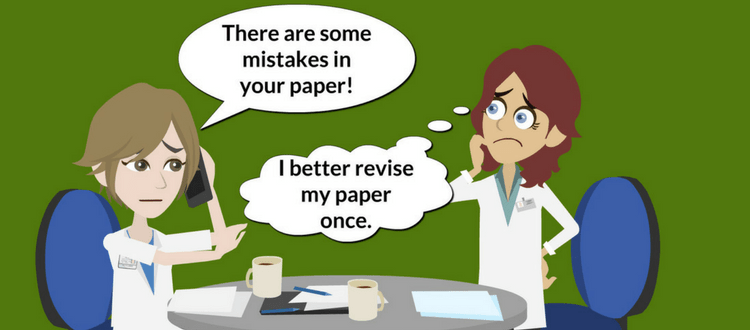Why Are Manuscript Revisions Necessary?

Just imagine, it is 1970 and you are a young physicist working in black hole theory, which was a new and startling topic in the early 1970s. You have discovered what comes to be known as the second law of black hole dynamics, a significant scientific discovery. You realize the importance of your work, and you wish to publish, but few traditional journals will accept a manuscript on what is very unconventional thinking in the scientific world. So most of the journals rejected your article. However, eventually your article got published and you became famous. Your name is Stephen Hawking.
How would you have felt as a young, unknown researcher if your first article was rejected by major scientific publishers? What could you have done to make the manuscript more “publishable”? Why didn’t the reviewers and editors recognize and encourage the worth of the paper? Do you think a revision of manuscript could assure successful acceptance the first time? Let us try to find out.
Why Do a Manuscript Revision?
To answer this question, you must understand what a manuscript revision is and how the revision adds to its final value. The goal of revising a manuscript is to change it for the better. Revise means “to see again.” Revising might mean few changes, or it could mean making “large, sweeping changes, reorganizing part or all of the text, significantly adjusting tone and voice, or adding and removing chunks of text, as well as fixing grammatical errors.” Revising might be done by the author, the journal editor, or peer reviewers, who are experts in the applicable subject.
What is the Difference between Revising and Editing?
How do you distinguish between revising and editing? Revising is often called “self-editing.” When you sit down to reread your first draft, you will note down what you want to change. This process is revision. When you hire someone to bring a professional perspective to the text and make sure it’s clear and accessible for someone else, that is editing. You must realize this difference to know what to do and in what order. First you revise (work on it yourself until you’ve made it as good as you personally can), and then you edit (bring in a professional to make it better than you can). Realizing this difference enables you to know what to focus on in the document and to assure that it includes everything you intended to say.
Revisions fall into different categories. The first kind is the revision you do yourself. However, if you submit the manuscript to a journal, chances are it will be sent to one or more peer reviewers for their thoughts. A peer reviewer is an expert in the field who reviews the document, by adding comments. Revisions from the peer reviewers are then sent back to the author for comments. There are companies that can provide professional editing and peer-review services for your manuscripts.
How to Revise a Manuscript
Revision of manuscript is necessary, either from your own perspective or from the viewpoint of the peer reviewer. Things to consider are as follows:
- Who is your audience?
- To which journal or publishing house are you submitting?
- Have you maintained the word limit for your manuscript?
- Did you check the reference protocols?
- What is the average acceptance rate for that publisher?
- How long will it take to do the review?
- Once you have gotten feedback from peer reviewers, which changes do you agree with and which do you want to reject?
- After you have finished revising your manuscript, experts agree that it is a good idea to set it down for some time and think about the manuscript as a whole. Are you sure you haven’t plagiarized anything? Have you proofread the document before submission? Most reviewers take two to three months to return a manuscript. When you return the revised manuscript to the peer reviewers, you should be certain that you have addressed all the comments and responded in a polite manner. Criticism never gets appreciation in the world of reviewing.
Peer reviewers provide you with a marked-up copy of your manuscript, showing the changes made since the original submission. The best way to make changes on a manuscript is by using the “Track Changes” option in Microsoft Word. It is best to upload a revised document with a different file name than the original. The revised file shows the changes highlighted. Authors and peer reviewers can make changes using different colored fonts to distinguish who has done what.
Instructions for Preparing a Revised Manuscript
To style and format your revisions, use the same guidelines as for submitting an original manuscript. When submitting a revision, be sure to include the following:
- Follow editorial guidelines
- Submit figures, graphs, and tables in a separate file
- Use double spacing throughout the text
- Use Times New Roman or Symbol fonts
- Prepare equations using standard equation symbols
- Prepare files for 8 ½ by 11-inch paper size
- Define acronyms after the first use
- Number tables and figures in order
- Don’t refer to data, not shown in the main manuscript
Do unto Others
Only nine percent of the 6,000 annual manuscript submissions to the Journal of the American Medical Association are accepted for publication the first time. Therefore, you can expect some rejection after submitting your manuscript for the first time and perhaps even after major revisions. The purpose of manuscript revisions is to improve your chances of acceptance. Review yourself well and then accept the good advice of others. Once that is done, feel assured that you will not regret the time you spent revising.
What are the key points a researcher needs to keep in mind while revising one’s own manuscript? Please let us know your thoughts in the comments section below.









